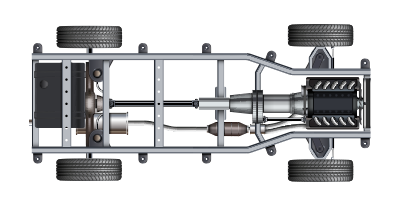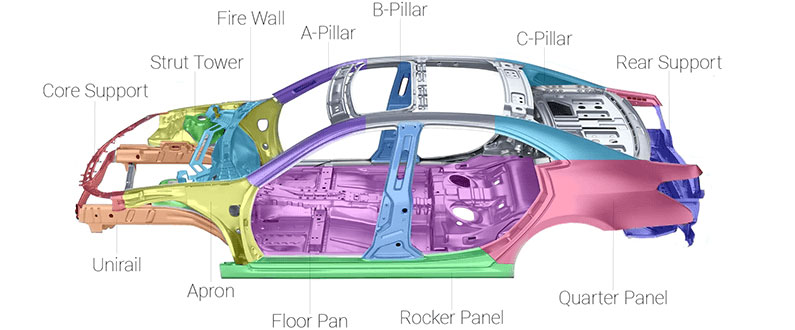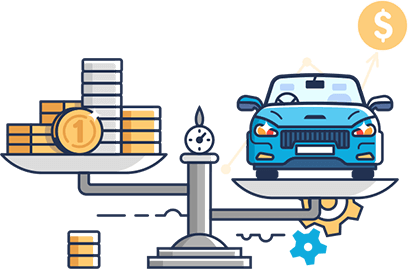Your vehicle's frame provides the structure for your entire vehicle, and any damage to the frame can result in overall structural weakening.
A weakened vehicle frame could behave in unpredictable and dangerous ways in the event of an accident, causing severe harm or even death to the driver and passengers inside.
Repairing the damage will not necessarily restore structural strength to your car, which means in most cases it makes more sense to sell it than to fix it.
How Do I Know if My Car Has Frame Damage?
Imagine your vehicle was involved in a heavy front end collision. You see the fenders crumpled up like accordions, the radiator support smashed up onto the engine, and there are two metal beams sticking out at you like sore thumbs.
Coming out of an accident unharmed would be one lucky day but your car won't have that luck, there's a good chance you have just damaged the structural frame of the car and it might never drive or be as safe again.
Before embarking on the long and expensive journey of repairing a vehicle’s frame it's important to be well informed of what frame damage is and what it means to make the smart decision.
If your car has sustained any heavy physical damage, then you may have some of these questions.
-
What is frame damage?
-
What kinds of car frames are there?
-
Is it safe to drive with frame damage?
-
How much does it cost to fix a car with frame damage?
-
Is it worth fixing my car after an accident?
-
What are my other options?
In this article, we will cover these questions and more.
Most unibody vehicles have what is called crumple zones. These are indented sections of the frame that make a light wavy shape. They’re typically found in the front engine bay and in the rear support of the car. They are designed to literally fold in like an accordion after a crash from to absorb the energy of an impact. If you have unibody damage that isn't worth it to repair, you can sell your car in 24-48 hours online!
Frame damage can cost you more to fix than what the car is worth. Before you start any repairs, check the value of the car and see if the repairs are worth it.
What is a Frame Damaged Car?
Deep down beneath all the parts in your car, there is a structural support system — the frame of your car. It's designed to protect you in case of an accident and it's the foundation that your car is built on.
The term “frame damage” is used whenever the integrity of your frame has been compromised by either an accident or by third party alteration.
When there is frame damage reported, this means there may be damage to parts of the vehicle that provide structural support. Since the frame is the foundation of your car, frame damage is typically a huge deal.
What Are The Different Types Of Frames?
Almost every car has a unique frame designed by the manufacturer, but there are many different types of frame. The most common are unibody frames and ladder frames.
Unibody frame
 One of the most common forms of a vehicle's frame is a unibody frame, meaning that the body and frame of the vehicle car are one piece.
One of the most common forms of a vehicle's frame is a unibody frame, meaning that the body and frame of the vehicle car are one piece.
This type of frame can be broken down into several parts to describe their location and purpose. If the unibody frame of a vehicle is damaged it may result in a bent frame on a car.
A bent frame means the car might not drive straight, and even after repairs it will still be weaker in the area where it’s been damaged.
So what makes up a unibody frame?
-
Core support: Also known as the radiator support, this section of the frame can be found on the front end of your car. In some vehicles, this part is bolted on and can be removed or replaced without being considered “frame damage.”
-
Unirail: Two symmetrical metal beams located at the front and back of the car. These rails are one of the strongest parts of the frame and are also the foundation for other components that will get welded onto these rails, like the apron for example.
-
Strut tower: Every vehicle has four strut towers that are typically located on the four corners for the car. The strut tower is also part of the front apron and rear quarter panel. They are designed to align and hold your vehicle's suspension in place.
-
Apron: This is the front inner fender area of the vehicle with two sides. The front of the apron extends from the core support to the strut tower and the rear apron extends from the strut tower to the firewall.
-
Firewall: This is the part of the frame that separates the motor from the cockpit. The firewall alongside the apron, strut tower, front rails and core support make up the front unibody and engine bay of a car.
-
Floor pan: This is a metal sheet that is welded to several cross members to form the floor of a vehicle. The floor pan will also have several grooves and holes to fit the vehicle's drivetrain and electric wiring.
-
A-B-C-Pillars: These are the vertical supports of the car. They are labeled alphabetically to represent their location from front to rear. Certain vehicles like minivans will have a fourth pillar called the D-pillar to support extra length.
-
Rocker panel: Located on both sides of the vehicle in between the wheels and under the doors. These panels support your doors and help align them when closed.
-
Quarter panel: This is the metal sheet that forms the left and right rear panels of your vehicle. They help form the wheel well and in most cars, you will find the gas cap on it. For most vehicles, the quarter panel will be made of metal but in unique vehicles like a Corvette, the quarter panels can be made from fiberglass or carbon fiber.
-
Rear support: The rear section of the frame. On common cars, the rear support is composed of two unirails, a floorboard (where your spare tire goes) and a rear bumper support.
Ladder Frame
 This is one of the oldest designs of a frame. Traditionally almost all cars were made with this concept, but now it's more common on trucks due to its high resistance and strength.
This is one of the oldest designs of a frame. Traditionally almost all cars were made with this concept, but now it's more common on trucks due to its high resistance and strength.
The core foundation is made up of two symmetrical rails that are the same length as the car and are connected by several cross members.
The power and drivetrain are placed onto the frame, then the body of the car is placed onto this “ladder” to complete the vehicle assembly.
The benefit of the ladder frame is that body damage does not necessarily damage the frame of the vehicle, making it easier to repair in the event of collision with an object higher off the ground.
Our expert evaluators can help you get an accurate estimate for your cars value, FAST!

Does Frame Damage To A Car Make It Unsafe To Drive?
That depends on the answer to the following questions:
-
Are the four wheels well-aligned?
-
Can the car drive in a straight line?
If so, then it is not necessarily unsafe to drive the vehicle — it will be able to transport you safely. Of course, if the answer to either of the two questions above are no, then the vehicle is not safe to drive at all.
However, the real test comes in a collision. The section below expands on the real danger behind frame damage.

Is A Car With Frame Damage Safe In A Collision?
If you have extremely minimal damage, such as a minor dent in an insignificant place, then your vehicle may still be completely safe in an accident.
However, frame damage is rarely that simple. Bent rails, a damaged crumple zone, a weakened strut tower… any damage to the key components of the frame becomes a critical weak point in an accident.
If your car has frame damage and is involved in a heavy collision, chances are your vehicle is simply not going to perform the way it was designed to in an accident.
Car frames are designed to crumple in very specific ways upon impact. The intent behind the design is to ensure that if a car is involved in a heavy collision, no part of the car will bend in or squash in such a way that it maims the driver and passengers.
However, if the frame is injured or has weak points, the vehicle will not behave predictably, and a car designed to protect could instead severely harm or even kill you.
Even if your vehicle’s frame damage has been repaired and welded up, it will never again perform the way it was designed to in an accident.
Think of it like a tin can: if you crush it, you can theoretically pound and straighten it back to something resembling its original shape. But the structure is now permanently weakened, and it will take a lot less force to crush the can a second time.
The same applies to your car after frame damage.
How Much Does Vehicle Frame Damage Repair Cost?

How much it costs to repair vehicle frame damage depends on the severity of the damage.
As a low-end hypothetical, assume a car is backing out of a spot in the grocery store and bumps into your Honda Civic’s quarter panel, leaving a basketball-sized dent. This is technically frame damage — but you’re not likely to pay more than $600 to $1000 to fix it.
On the other hand, however, let’s say your radiator support, frame rail or even your apron is damaged. In that situation, you would need to cut off the part and weld a new one onto the frame. Then an industrial machine will need to clamp onto the car and stretch it back out.
Repair like that could cost you well over $10,000.
In short: structural repairs are one of the most expensive repairs a car can need, if the damage impacts the frame.
What's My Frame Damaged Car’s Value?
Vehicle frame damage could have a negative effect on a vehicle's value depending on the extent of the damage.
Keep in mind that if a vehicle’s damage is noted in its history, that damage will permanently appear in the car’s record, which means its value will always be lowered even if you repair it to the best of your ability.
This is because any buyer looking to purchase your vehicle knows that it has a history of frame damage, making it less appealing than a car that is guaranteed to be structurally intact.
In cases where the vehicle has sustained major frame damage, then there's a good chance it's time to sell.
Can I Sell My Car With Frame Damage?
Repairing frame damage after a collision is complicated and you will never have the peace of mind that your vehicle will be up to manufacturing safety standards.
Front end damage to a car, or rear end collision damage to a frame can both result in a bent car frame, which is difficult and expensive to repair.
Sometimes the best choice is to sell your vehicle and avoid any further depreciation. If you want to turn that wrecked or junk car that has a banged up frame, then sell it to CarBrain. We are experts ready to help you sell your car online.
We’re the smart way to sell your car. Our state-of-the-art price engine is designed to make offers on most makes and models in just 90 seconds!
We’ll also deliver the payment right to you and tow the car for free in just 24 to 48 hours!
The process is quick and simple. Click the button below to get an offer today!




